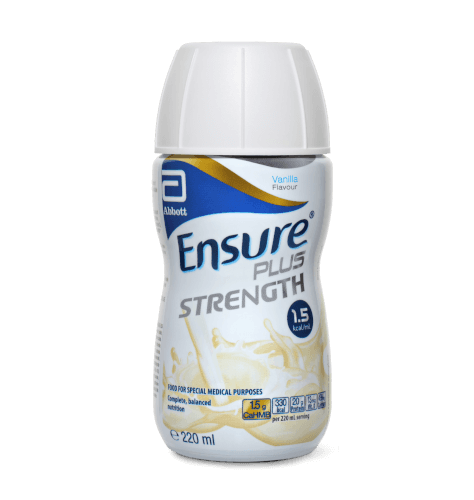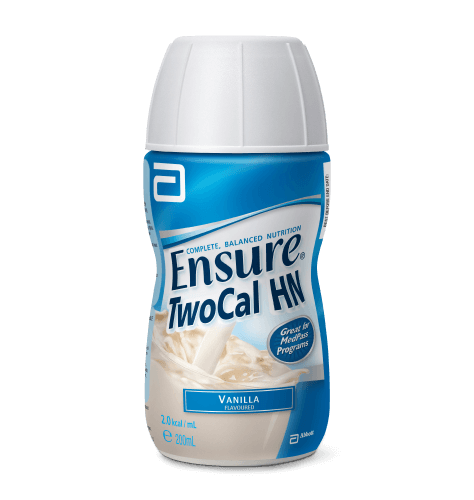Protein
Provides the amino acid building blocks that are essential for muscle growth and repair.2,3
Ensure provides complete, balanced nutrition to support muscle mass and strength, and contains:1
Important for preserving muscle strength and supporting normal muscle function.4–6
Skeletal muscle accounts for 40% of total body weight,8 and plays an important role in strength, movement and balance. Muscle mass and strength peaks around the age of 25 years, and gradually decreases as you get older.9–11 As we age, you can lose up to 15% of muscle mass every decade.9 It is important to take care of your muscles at any age.

Maintaining healthy and strong muscles can help:
To improve balance and coordination, reducing the risk of falls
Maintain mobility and independence
Keep joints in good shape
Improve energy levels
Support the immune system
Loss of muscle mass, strength and function have been associated with poor health outcomes including increased falls and fractures.12

Exercises that involve the use of your bodyweight (or other equipment) to resist the contraction of your muscles are called resistance exercises. These exercises are the most effective way of improving muscle mass and strength when combined with good nutrition.13,14
"Here's a simple daily exercises that you can try at home:"
Track your leg strength by retaking this test daily.13 Sit, stand, and measure your progress! Simply:
1. Sit comfortably, arms crossed
2. Stand tall, then sit back down, repeating five times
3. Time yourself aiming for five reps in 11 seconds or less
If you have concerns about your muscle health, please consult a healthcare professional


Maintain muscle strength and support bone health

Maintain muscle strength and bone health without flavour

Low volume, high-energy for those who have difficulty drinking larger volumes

High protein and CaHMB to support muscle strength and recovery.15–18

High calorie, protein dense to help gain and maintain healthy weight19

Strength and energy for malnutrition risk, surgery, injury or illness recovery.20
Food for Special Medical Purposes. Use only under medical supervision.
*8% loss every decade between 40–70 years of age, and 15% per decade over 70.21
References: 1. Ensure® Product label. 2. Harvard School of Public Health. The Nutrition Source – Protein. Available at: https://www.hsph.harvard.edu/nutritionsource/what-should-you-eat/protein/ Accessed: April 2023. 3. Nutrient reference values for Australia and New Zealand (Protein). Available at: Available at: https://www.eatforhealth.gov.au/nutrient-reference-values/nutrients/protein Accessed: April 2023. 4. Wagatsuma A and Sakuma K. Biomed Res Int. 2014;2014:121254. 5. Harvard School of Public Health. The Nutrition Source – Vitamin D. Available at: https://www.hsph.harvard.edu/nutritionsource/vitamin-d/ Accessed: April 2023. 6. Nutrient reference values for Australia and New Zealand (Vitamin D). Available at: https://www.eatforhealth.gov.au/nutrient-reference-values/nutrients/vitamin-d Accessed: April 2023. 7. The Nutrition Source – Calcium. Available at: https://www.hsph.harvard.edu/nutritionsource/calcium/ Accessed: April 2023. 8. Frontera WR and Ochala J. Calcif Tissue Int. 2015;96(3):183–95. 9. Baier S, et al. J Parenter Enteral Nutr. 2009;33:71–82. 10. Janssen I, et al. J Appl Physiol, 2000; 89: 81–88. 11. Grimby G, et al. Acta Physiol Scand. 1982; 115: 125–34. 12. Deutz NEP, et al. J Am Med Dir Assoc. 2019;20(1):22–27. 13. Dodds RM, et al. JCSM. 2021;12(2):308– 318. 14. Sherrington C, et al. Br J Sports Med. 2017;51:1749–1757. 15. Ensure® Plus Strength Product Label. 16. Deutz NE, et al. Clin Nutr. 2016;35(1):18–26. 17. Ekinci O, et al. Nutr Clin Pract. 2016; 31(6): 829–835. 18. Malafarina V, et al. Maturitas. 2017;101:42–50. 19. Ensure® TwoCal HN Product Label. 20. Ensure® Plus Product Label. 21. Slavin J. Nutrients. 2013;5(4):1417–35. 22. Puertollano MA, et al. Curr Top Med Chem. 2011;11(14):1752–66. 23. Walsh NP. Sports Med 2019;49(Suppl 2):S153-S168. 24. Harvard School of Public health – The Nutrition Source (Zinc). Available at: https://www.hsph.harvard.edu/nutritionsource/zinc/. Accessed: April 2023. 25. Mayo Clinic Health System – Support your immune function with good nutrition. Available at: https://www.mayoclinichealthsystem.org/hometown-health/speaking-of-health/support-your-immune-function-with-good-nutrition Accessed: April 2023. 26. Prietl B et al. Nutrients. 2013;5(7):2502–21.
ANZ.2024.50334.ENS.1
Links which take you out of Abbott worldwide websites are not under the control of Abbott, and Abbott is not responsible for the contents of any such site or any further links from such site. Abbott is providing these links to you only as a convenience, and the inclusion of any link does not imply endorsement of the linked site by Abbott.
The website that you have requested also may not be optimized for your screen size.
Do you wish to continue and exit this website?


ANZ.2024.53720.ENS -GLU -PDS.1 (v1.0)